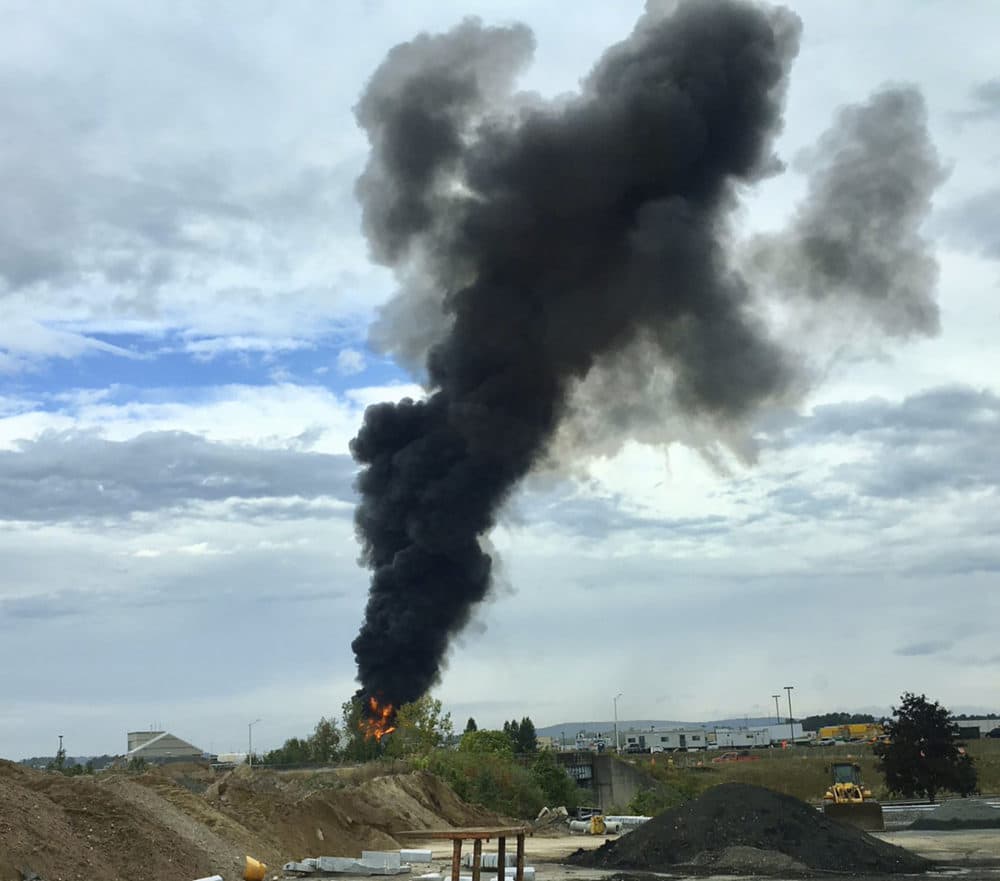Advertisement
Deadly Crash Of WWII-Era Bomber Wasn't The First Accident For Mass. Foundation
Resume
Vintage airplanes operated by the Massachusetts nonprofit whose World War II-era bomber crashed and killed seven people Wednesday have been involved in five other accidents since 1987, according to federal records.
None of the previous accidents were fatal. Causes varied but appear to underscore the difficulties of maintaining and operating aging aircraft.
"When you fly in a restored World War II airplane, there is more risk than flying a commercial airliner," said Keith Mackey, a pilot and aviation safety consultant who has flown the plane that went down in Connecticut. The four-engine Boeing B-17, manufactured in 1944, is known as "the Flying Fortress." It is owned by the Collings Foundation of Stow.
Mackey said he flew planes for the foundation about a dozen times in the 1990s and said he believed the B-17 was "well maintained and in good condition." He added that, in his experience, the foundation briefed passengers on the risks.
The Collings Foundation did not respond to an inquiry about its safety record but said in a statement that it "is fully cooperating with officials to determine the cause of the crash of the B-17 Flying Fortress and will comment further when details become known."
The foundation's website was down Thursday, replaced by a page featuring the statement. According to an archived page, rides in the foundation's planes start at $400, and opportunities to "actually fly the plane" start at $2,200.
One of the foundation's previous accidents involved the same plane that crashed and burned minutes after takeoff from Bradley International Airport Wednesday. In the foundation's account of the accident, on an archived webpage, the B-17 "was caught by a severe crosswind moments after touchdown" in Beaver Falls, Pennsylvania, in 1987, and "despite the efforts of her crew, she rolled off the end of the runway."
According to a report by the National Transportation Safety Board, however, winds were gusting as the plane approached, and investigators faulted the pilot for excessive airspeed and failing to perform a "go around," which would have delayed the landing until conditions were calmer.
Three people were injured, one seriously.
Two months earlier, a B-25 from the same era suffered "substantial" damage, according to the NTSB, when it landed short of a runway in Stow. The three people on board were not injured. The pilot told investigators that he "felt and heard the hydraulic line burst in the cabin, which left the aircraft without brakes."
In another incident, in 1997, a single-engine Chance Vought F4U ran out of fuel and landed in water near New Smyrna Beach, Florida. The pilot, flying alone, was not injured and told NTSB investigators that a gauge on the plane, manufactured in 1951, had indicated adequate fuel before takeoff. Investigators faulted him for neglecting to check the fuel level with a dipstick.
In an accident five years ago, landing gear collapsed on a recently reassembled Curtiss Wright P-40B, manufactured in 1941. The pilot had little experience flying that model and lost control of the plane upon landing in a crosswind in New Smyrna Beach, according to an NTSB report. No one was injured.
Two people suffered minor injuries in 1993 when the right engine on a Douglas B-26B, manufactured in 1944, lost power shortly after takeoff in Kankakee, Illinois. NTSB investigators found that a piston in one of the engine's cylinders was fractured and partially disintegrated.
"Old airplanes are very challenging to maintain," said John Cox, chief executive of Safety Operating Systems, an aviation consulting firm in Washington. "Some are very challenging to fly."
Cox added that in his opinion, the Collings Foundation "does a good job maintaining and safely flying these magnificent pieces of history."
The Collings Foundation takes World War II-era planes on tour and runs the American Heritage Museum in Hudson, which it opened after receiving a large donation of military vehicles in 2013.
Robert Collings Jr., the foundation’s executive director, has seen his pay increase dramatically in recent years. His pay has risen from $75,000 in 2013 to $338,077 in 2017, the latest year reported by the nonprofit group. In the four-year period that ended in 2017, he was paid more than $1.1 million in charitable funds.
In the filings, he reports working 40 hours a week. The foundation reports $94 million in assets, most of that related to its aircraft and other collections.
A spokesman for the foundation did not respond to questions about Collings' compensation.
Frank Dworak, a trustee of the foundation reached by phone at his home in Rocky Hill, Connecticut, on Thursday, said the board meets annually and, among its duties, researches and approves Collings' pay. He said the Collings family has "high integrity," in his view.
"I'm proud to have been associated with them," he said. "We're looking forward to getting beyond this tragedy and getting to the bottom of the causes."
Dworak added that he has flown on many of the foundation's planes and said the pilot of the plane that crashed "has more B-17 experience than anybody else in the world."
This segment aired on October 4, 2019.

